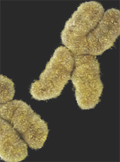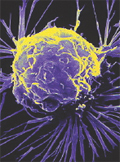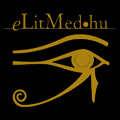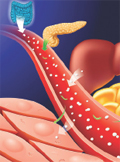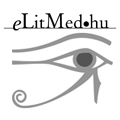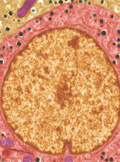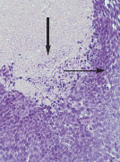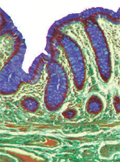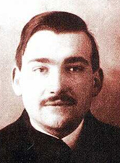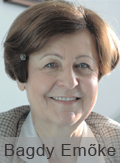The eLitMed.hu medical portal uses computer cookies for convenient operation. Detailed information can be found in the Cookie-policy.
Lege Artis Medicinae - 2012;22(01)
Content
[Genetic background of thyroid cancers]
[Molecular genetics has become an indispensable diagnostic tool in a number of diseases. The most frequent thyroid tumours are associated with genetic alterations that might be used for diagnostic purpose in the future. Somatic mutations and rearrangements in BRAF, RAS family RET/PTC and PAX8/PPAR-gamma genes may occur in papillary and follicular thyroid carcinomas. Other mutations of the RET gene can be found in medullary carcinomas (in sporadic as well as hereditary types), whereas mutations of the genes TP53, RAS, and BRAF are associated with poorly differentiated and anaplastic carcinomas. At present, the most reliable diagnostic tool for the differential diagnosis of thyroid nodules is fine-needle aspiration cytology. However, the existing malignancy cannot be unequivocally proven in up to 10-40% of all samples. On the basis of previous results, genetic examination of fine needle aspiration samples from thyroid nodules can contribute to a more precise diagnosis and the timely removal of potentially malignant nodules.]
[Complex pathological diagnosis of breast cancer and the patient care based on it over the past 20 years]
[The diagnosis of breast cancer has become more complex in the past 20 years. Intraoperative diagnosis has been mostly replaced by multidisciplinary preoperative/ nonoperative diagnostics. Surgical treatment can be planned in advance for the breast as well as for the axilla. In many cases, routinely performed radical surgery has been replaced by selectively applied, less radical, conservative operations (sectoral or wide local excisions, sentinel lymph node biopsy) that are suitable for smaller tumours mostly detected by screening. In addition to prognostic markers listed in the pathology reports (lymph node status, tumour size, vascular invasion, status of resection margins), an increasing emphasis has been placed on predictive markers (estrogen receptors, progesterone receptors, HER-2, basal and proliferation markers) that allow molecular typing of breast carcinomas and that mostly influence systemic treatment. Tools to predict the efficiency of treatment have become increasingly available, and these might also help in planning neoadjuvant therapies, a modality which has also been introduced in the past 20 years. The present article gives a brief, subjective, thematic insight into some of these changes, selected on the basis of their relation to the pathological diagnosis of breast carcinoma.]
[Antidiabetic therapy of patients with type 2 diabetes - The role of incretin mimetics]
[Incretin mimetics represent a new group of antidiabetic drugs. They bind to their own receptor on the beta-cell membrane and increase insulin secretion in a glucosedependent manner. Thus, they rarely cause hypoglycaemia. Furthermore, they significantly reduce body weight and other cardiovascular risk factors. Accordingly, they can be considered as an optimal group of antidiabetic drugs. The author reviews the clinical efficacy and safety of currently available incretin mimetics.]
[Efficiency and safety of the vaccination against H1N1 influenza virus in inflammatory bowel disease]
[INTRODUCTION - Inactivated influenza and H1N1 vaccination is recommended yearly for patients with inflammatory bowel disease receiving immunosuppressive therapy; however, immunomodulator and biological therapy might impair the immune response to the vaccination. In our study, we assessed whether immunity can develop in response to H1N1 influenza vaccination in patients receiving immunomodulator and/or biological therapy. We also assessed the occurrence of side effects after the immunisation in these patients. PATIENTS AND METHODS - In our prospective study, blood samples were obtained from 24 patients (12 Crohn’sdisease, 12 ulcerative colitis) one month after immunisation against influenza A/California/ 07/2009 (H1N1) virus. At the time of vaccination, all patients have been receiving immunomodulator and/or biological therapy for at least three month. Antiviral antibodies were detected by using microneutralisation assay. The safety of the vaccination was assessed by questionnaires. RESULTS - Every patient developed complete immunity against influenza A (H1N1) virus, independently from the type of immunosuppressive therapy. Regarding side effects, local symptoms occurred in six patients and systemic symptoms in another six patients. Mild diarrhea occurred in five patients. Moderate exacerbation of the disease was observed in 2 patients with Crohn’s disease and in one patient with ulcerative colitis. CONCLUSIONS - According to our results, immunocompromised patients with IBD can be safely advised to receive the vaccination. In our study, all patients developed adequate immunity according to microneutralisation titers.]
[Optimalisation of basal insulin regimen for adolescent patients with type 1 diabetes]
[INTRODUCTION - During the total phase of type 1 (insulin-dependent) diabetes mellitus (T1DM), both the quantity and the quality of daily insulin doses must be determined to help the daily blood-glucose profile approach normoglycaemia, derived from the patient’s diet and regimen. Adolescence for young people with T1DM is a rather stressful - often shocking - psychosomatic state, due not only to the increased - but erratic - secretion of contrainsular hormones (predominantly growth hormone), but also to the special mental state of the child. Accordingly, choosing the right kind and amount of basal insulin to compensate the contrainsular effect is crucial for optimal treatment during this stage of life as well. CASE REPORT - We describe the process of optimising metabolic balance and basal insulin demand in a 11-year-old, adolescent girl with T1DM for 7.5 years using glargine insulin. In order to achieve this goal, both the dosage of glargine and the daily schedule of its administration needed to be modified. CONCLUSIONS - To achieve optimal metabolic results, both the quantity and the efficacy curve of basal insulin must and can be adapted to the actual stage of general somatic development. The demand for basal insulin during puberty may be well beyond the widely approved limit of 50%. Adapting the administration of glargine insulin to a daily schedule has the potential to counterbalance increasing contrainsular effects.]
[Pilomatrix carcinoma with a lymph node metastasis - First Hungarian publication of a rare case]
[INTRODUCTION - Pilomatrix carcinoma is a very rare malignant tumour, which derives from hair matrix cells. The male:female ratio among patients is 4:1, the mean age of patients is 45 years. This tumour type is very aggressive and grows slowly. CASE REPORT - The authors describe the case of a 37-year-old man who presented in 2004 with an approximately 2×2 cm, compact lesion tumour in the lumbar region. The tumour was excised and diagnosed as carcinoma sebaceum on the basis of histological examination. Several weeks after surgery, a protruding, semi-spherical lesion with a diameter of 2 cm appeared in the scar. The patient was referred to our hospital for excision of this lesion and for assessing the possibility of Muir-Torre syndrome. The examinations did not indicate the presence of any internal tumours. The recurrent tumour was excised with a 2 cm intact margin. Histological examination confirmed the diagnosis of pilomatrix carcinoma. In 2005, two new tumours were excised and semithick skin was transplanted in several sessions. At an oncological follow-up examination in 2009, a 13×7 mm lymph node was felt in the righ inguinal region, which was found to be a metastasis of pilomatrix carcinoma on the basis of aspiration cytology. Surgical block dissection was performed, followed by postoperative radiotherapy at a dose of 25×2 Gy. At present, the patient is symptom- free. Thoracic-abdominal CT and clinical examination performed in early June 2011 did not indicate progression of the original disease. CONCLUSION - Pilomatrix carcinoma with a lymph node metastasis has not been previously reported in Hungarian. The diagnosis was established on the basis of histological examination, which was indispensable for successful treatment.]
[How do physicians sleep and dream?]
[INTRODUCTION - Satisfying sleep is especially important for physicians. Our study analyses physicians’ sleep and dream from the point of view of continuous nightand- day duty. SAMPLE AND METHOD - Questionnaires were completed by 125 physicians among whom the proportion of night shift taking and only day-time working persons was equal. The questionnaire contained the Athens Insomnia Scale and the Dream Quality Questionnaire as well as questions about demographical characteristics and work circumstances. RESULTS - Almost each doctor mentioned sleep problems, principally daytime sleepiness (78%) and sleep deprivation (70%). Long sleep latency is reported more often by women doctors; the frequency of night awakenings increases, while daytime sleepiness decreases by age. The feeling of performance-loss is more prevalent among night shift takers. Dream characteristics differ significantly neither along demographical characteristics nor by work shifts. CONCLUSION - Although sleep problems are more frequent among physicians when comparing to the Hungarian general population, the frequency of clinical level insomnia is not higher. On the other hand, physicians can recall their dreams more often (25% vs 7%) and the emotional load of their dreams influence their daytime mood more commonly.]
1.
Clinical Neuroscience
Is there any difference in mortality rates of atrial fibrillation detected before or after ischemic stroke?2.
Clinical Neuroscience
Factors influencing the level of stigma in Parkinson’s disease in western Turkey3.
Clinical Neuroscience
Neuropathic pain and mood disorders in earthquake survivors with peripheral nerve injuries4.
Journal of Nursing Theory and Practice
[Correlations of Sarcopenia, Frailty, Falls and Social Isolation – A Literature Review in the Light of Swedish Statistics]5.
Clinical Neuroscience
[Comparison of pain intensity measurements among patients with low-back pain]1.
Clinical Neuroscience Proceedings
[A Magyar Stroke Társaság XVIII. Kongresszusa és a Magyar Neuroszonológiai Társaság XV. Konferenciája. Absztraktfüzet]2.
3.
Journal of Nursing Theory and Practice
[A selection of the entries submitted to the literary contest "Honorable mission: the joys and challenges of our profession" ]4.
Journal of Nursing Theory and Practice
[End of Life and Palliative Care of Newborns in the Nursing Context]5.
Journal of Nursing Theory and Practice
[Aspects of Occupational Health Nursing for Incurable Patients ]



